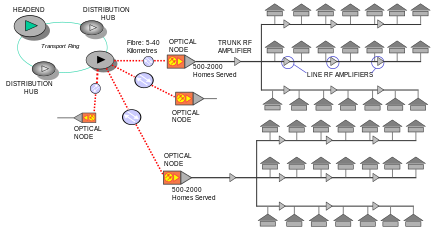In the past when I've called xfinity (ie Comcast) about an outage I was usually told there was a "partial node outage" affecting your area. You could Google that and find that it's something that happens quite often. Its even in their trouble tickets. Unfortunately, its not really clear what it mean. I've asked their call center techs many times but never gotten an answer as they don't seem to know either.
So what is a node exactly?
Before we can get to that we need a bit of background. First, your cable provider utilize a HFC (Hybrid Fiber Coax) network; which is part fiber optics and part coaxial. The optics cabling provides the long distance transport of all their content; eg video, voice and data, from their main local facility (ie a headend or a hub) to the nodes in your local community.
The nodes; also called "fibre nodes", "optical
nodes" or HFC nodes, converts light energy (via fiber optics) back into RF (via coaxial cabling). This is the same coaxial cabling that you have in your home. There are multiple nodes serving some large
communities.
A hypothetical HFC looks something like this.
So what does a node actually look like?
Here are some photos from DSLReport's FAQ page. You might has seen these in your neighborhood. They may also be installed in little green pedestals on your neighbor's front lawn.
Now you know what it is so why does it fail? Why the partial node outage?
Basically anything that could go wrong from the node to your home is classified as a "partial node outage". Per the diagram above, this could include something wrong with the line amplifier; either worn out or damaged due to a power surge, or the transmitters on the node itself causing it to generate signals beyond the specifications, or maybe the cabling between the node to the tap (ie the little green silos) were chewed up by animals, or it could simply be a failed power supply.
For the most part active (ie powered) devices are or could be monitored by your cable operator. So when you call to report an outage they seem to already know and the phone system ask you to check back later or they'll SMS you when its cleared. Operators also do end-to-end monitoring by polling CPE (ie cable modem) at your residence. What they cannot usually monitor are all the passive components of their network; like splitters, couplers or sub runs, etc,
Sadly to say however, a more pragmatic reason for most of the outages are probably outdated equipment and components, SPOF (single points of failures) design, lack of proactive monitoring and preventive maintenance. It all comes down to cost. These gear are expensive and most companies will run them to the ground before they replace them.
-spud



No comments:
Post a Comment